Introduction
WordPress Push Staging Site Without Overwriting Database: Staging sites are crucial tools for WordPress developers and site managers to test new features, plugins, themes, and design modifications without interfering with the actual site’s user experience. Moving updates from a staging site to production, however, presents significant difficulties, particularly with regard to maintaining important data in the production database. Any database overwrite has the potential to remove current content, including transactions, fresh comments, and live user data.
This thorough tutorial explains how to move your WordPress staging site to production without affecting the production database. Here is everything you need to know for a safe and seamless transfer, from planning and deployment tactics to troubleshooting advice.
Understanding Staging Sites and Database Challenges

A staging environment is essentially a clone of your live site, allowing you to test updates and changes without affecting what your users see. Pushing updates from a staging site to production can be tricky, especially because:
- Live Data Sensitivity – Real-time data changes are always occurring on a live site, like user sign-ups, transactions, comments, or updated user profiles. These aren’t present on the staging site.
- Database Conflicts – The staging site’s database may have outdated or altered data that doesn’t align with what’s on the production site.
- Selective Syncing Needs – Instead of a full database migration, selectively syncing only files or specific tables helps prevent overwriting critical production data.
By syncing only the necessary files and keeping databases isolated, you avoid unnecessary data conflicts and preserve the integrity of your live site.
Preparing for a Non-Destructive Push
A successful staging-to-production push starts with preparation. Taking careful steps beforehand, like creating backups and choosing the right tools, minimizes risks and ensures that the live site stays intact.
Step 1: Create Backups
- Why Backups Are Essential – Backups provide a fallback option if anything goes wrong during deployment.
- Backup Tools – Reliable plugins such as UpdraftPlus, All-in-One WP Migration, or WP-CLI for command-line backups are popular and effective.
- Automate Backups – Set up automated backups for your production site to ensure regular safety points. Many hosting providers, like Rocon or WP Engine, offer automatic backup options as well.
Step 2: Identify Files to Sync
- Focus on Key Folders – Often, the files you need to update include:
- /wp-content/themes – For theme updates or customizations.
- /wp-content/plugins – For plugins you’ve tested or added.
- Custom uploads – Only if there are new media files on the staging site that are missing from production.
- Use Version Control – Version control tools like Git help track changes and support selective syncing, allowing you to deploy files without database conflicts.
A Step 3: Test Deployment in a Sandbox
- Create a Sandbox Environment – Many managed hosts offer sandbox environments, letting you simulate deployment without affecting live data.
- Verify Database Connections – Double-check that the staging site’s wp-config.php is connected to its own database, reducing risk to the live site.
Selectively Syncing Files and Avoiding Database Overwrite

After preparations are in place, deploy the necessary files from staging to production while ensuring the production database remains untouched.
Method 1: Using a Migration Plugin with Selective Syncing
- WP Migrate DB Pro: This powerful plugin allows selective syncing, letting you migrate specific files and folders while excluding the database.
- All-in-One WP Migration: Provides an easy setup for file-only transfers by letting you exclude database tables from the sync.
- How to Sync Files Only: Configure the plugin to sync only the required files, such as theme or plugin files, while excluding database tables.
Method 2: Using an FTP Client for Direct File Transfer
- FTP (File Transfer Protocol) clients like FileZilla or Cyberduck offer manual, selective file upload.
- Steps for FTP File Syncing:
- Connect to the production site using your FTP credentials.
- Navigate to the directories with updates, such as /wp-content/themes or /wp-content/plugins.
- Upload only the necessary files, ensuring you don’t overwrite other folders or inadvertently touch the database.
- Advantages of FTP: It offers precise control over which files get transferred, minimizing risks to the live site.
Method 3: WP-CLI Commands for Targeted Deployment
- WP-CLI (WordPress Command Line Interface) is a robust tool for advanced users, allowing for file-only syncs directly via command line.
- Steps:
- Sync the theme folder with wp theme install or wp theme update.
- Sync plugins without affecting the database using wp plugin install or wp plugin update.
- Benefits: WP-CLI allows for highly targeted deployments, reducing the chance of errors.
Using Git for Version Control and Selective Deployment
For those familiar with Git, it offers a streamlined method for tracking, managing, and deploying code changes while keeping the database independent.
Setting Up Git for WordPress
- Create a Git Repository: Initialize a Git repository within your WordPress directory to track file changes.
- Add a .gitignore File: This file helps you exclude sensitive or unnecessary items (such as wp-config.php or uploads) from Git’s tracking.
Deploying Updates Using Git
- Staging Changes: Commit changes made on the staging site, like theme adjustments or new plugin code.
- Pushing to Production:
- Connect the production server to your Git repository.
- Use git pull to update the production site with only the committed changes, leaving the database untouched.
- Rollback Option: If something goes wrong, Git makes it easy to roll back to a previous version.
Popular Git-Compatible Hosts
- Many managed WordPress hosts, like Rocon, Kinsta, and , WP Engine offer Git integration, which makes deployment safe and straightforward.
Configuring Your Staging Workflow for Database Independence
Keeping the staging and production databases independent is crucial to avoid overwriting any real-time production data.
Use Different Database Prefixes
Having different prefixes for staging and production databases reduces the risk of accidental data overlap. For example, use stg_ for the staging database tables and wp_ for production.
Adjust wp-config.php for Database Control
In the staging site’s wp-config.php, set unique database names, users, and passwords to ensure separation from production.
Database Syncing Best Practices
- Avoid full database syncing whenever possible, focusing instead on only the files or tables needed.
- Snapshot the Database: Take periodic snapshots of the production database as an extra layer of safety before deploying updates.
Advanced Options: Partial Database Pushes
In some cases, you may need to update specific database tables, like WooCommerce products, without affecting other tables, such as order history. Partial database syncing offers a solution.
Selective Table Syncing
- With WP Migrate DB Pro Advanced, you can selectively sync specific tables. For example, update only the wp_posts table for new products while ignoring tables related to user orders or transactions.
- Important Tables to Consider: Custom post types, theme settings, and product catalogs (e.g., wp_posts for products, wp_options for settings).
WP-CLI for Table-Specific Commands
- WP-CLI allows selective commands for specific database tables.
- Example: Use wp db export to export only relevant tables and then import these to production as needed.
Hassle-Free Staging Push for WordPress
Move your WordPress staging site to live without overwriting databases. Experience smooth updates with Rocon’s managed hosting. Sign up now!
Explore More
Troubleshooting Common Issues
Even with a careful approach, issues may arise when selectively syncing a staging site with production. Here’s how to troubleshoot common problems:
-
Missing Styles or Broken Links
-
-
-
Problem: After syncing, the production site may display missing styles, broken images, or 404 errors for resources linked within themes or plugins.
-
Solution:
-
Verify URLs – Make sure that media URLs and links within your theme files point to the correct production paths, not the staging environment.
-
Fix Path Differences – If staging and production environments have different URL structures, use a plugin like Better Search Replace to adjust URLs in your production database.
-
Check Browser Console for Errors – In your browser’s developer console, look for errors under the “Network” tab that can help pinpoint any missing files or paths.
-
Database Consistency Errors
-
-
-
Problem: The theme or plugins may attempt to retrieve data based on the staging database, leading to errors or empty content areas.
-
Solution:
-
Check Plugin and Theme Settings – Some plugins and themes store settings or configuration paths in the database. Recheck configurations in production to ensure these match your live environment.
-
Run a Quick Database Search – Use phpMyAdmin or WP-CLI to search for any staging-specific entries in the database, particularly in wp_options and wp_postmeta tables, and replace them as needed.
-
Clear Cache – Caching plugins or CDN (Content Delivery Network) settings may also need refreshing to reflect the latest changes.
-
-
Problem: If files or database tables are accidentally overwritten, critical data can be lost.
-
Solution:
-
Revert to Backups – If an accidental overwrite occurs, immediately restore the most recent backup for your production site. Many managed WordPress hosts provide quick backup restores within their control panel.
-
Double-Check Permissions – Before syncing, ensure your FTP client or deployment tool has the correct permissions set for the specific files being updated. Misconfigured permissions can lead to broader overwrites.
-
Use Git Rollback (If Applicable) – If you used Git for version control, Git’s rollback feature lets you restore to a previous version of your codebase.
Best Practices for Future Deployments
For smoother, less error-prone future deployments, here are some best practices to implement:
-
Regular Backups and Syncs
-
-
-
Why: Frequent backups help secure your production site’s data, reducing the risk of irreversible issues. Having up-to-date backups before every deployment ensures that even in the event of an error, you can quickly restore data and resume operations.
-
Automation Tips: Use a plugin like UpdraftPlus or VaultPress to schedule automatic backups of your production site. For added redundancy, store backups offsite (e.g., Google Drive, Dropbox).
-
Sync Only What’s Needed: Avoid unnecessary syncing of staging data; stick to selective syncing methods to prevent potential database conflicts.
-
-
-
Why: Automation minimizes manual error and improves consistency in deployments. Tools like GitHub Actions, Bitbucket Pipelines, or CI/CD platforms can be configured to automatically sync files between staging and production, reducing the need for manual FTP or plugin migrations.
-
Automate Selective Backups and File Syncs: Automate the syncing of specific folders (themes, plugins) with plugins that offer file filtering options or use Git deployment on supported hosts. Tools like WP Migrate DB Pro can also automate partial database syncing, which is helpful for handling selective data without affecting critical database tables.
-
Use Scripts and Scheduling: Create scripts to schedule selective syncs and backups. Many hosts allow you to run CRON jobs or scripts, so you can automate regular file syncs or backups at times when your site’s traffic is lower.
-
Deploy During Low-Traffic Hours
-
-
Why: Deploying updates during off-peak times allows you to identify and fix any potential issues with minimal disruption to users.
-
Determine Low-Traffic Periods: Use Google Analytics or your hosting provider’s metrics to identify the times when traffic is lowest. Weekday late evenings or early mornings are usually ideal for maintenance.
-
Stagger Updates: If possible, stagger updates (e.g., update themes first, plugins second) rather than pushing all changes at once. This reduces the load on your server and allows you to monitor individual changes for issues.
Conclusion: WordPress Push Staging Site Without Overwriting Database
Thoughtful staging routines, selective syncing technologies, and careful preparation can help you deploy a WordPress staging site to production without overwriting the database. The techniques described here will enable you to move changes without jeopardizing data integrity, guaranteeing the stability of your live site and the security of your user data.
WordPress Push Staging Site Without Overwriting Database FAQs
1. How to push staging site to live in WordPress?
Pushing a staging site live in WordPress involves syncing your staging changes to your main site. To do this, use a reliable plugin or your hosting provider’s tools. Ensure you back up your live site first. Once ready, deploy your changes carefully, testing afterward to confirm everything works smoothly. Providers like Rocon make this process efficient and secure your website.
2. How do I move my WordPress staging site to production?
To move your WordPress staging site to production, start by backing up your live site. Next, use a migration tool or hosting service to migrate files and database updates. Rocon’s managed hosting provides seamless tools for this process, ensuring your data and changes are applied without hassle.
3. How to move from staging to production?
Moving from staging to production requires a reliable process. Begin by confirming all updates work perfectly in staging. Back up your live environment and use a migration tool or host’s feature to move files and the database. Hosting providers like Rocon can streamline the migrate, maintaining site integrity and uptime.
4. How do I redesign a WordPress site without going live?
To redesign a WordPress site without affecting your live version, create a staging site where you can safely make edits and preview changes. Use tools provided by hosting providers or plugins. Rocon’s hosting services offer robust staging features, enabling stress-free redesigns without impacting your visitors.

Leave a Reply